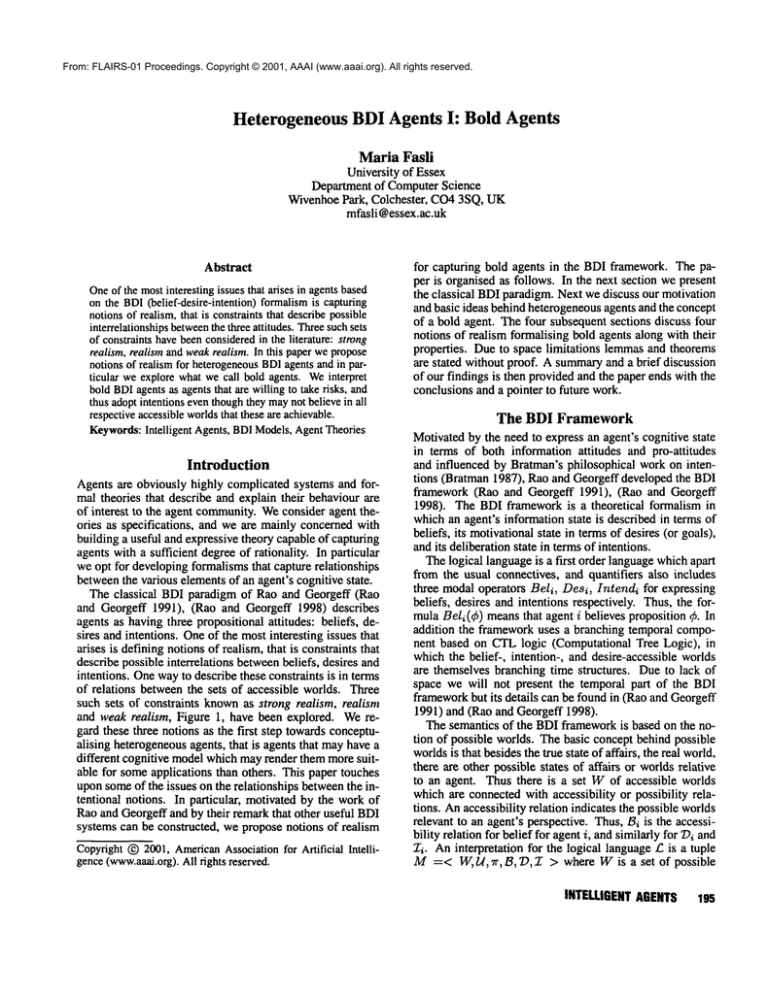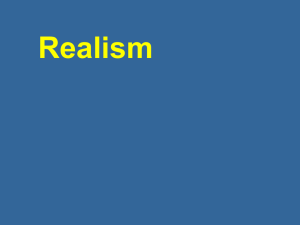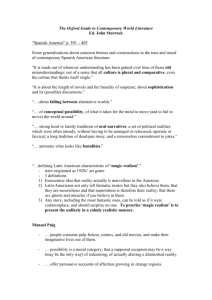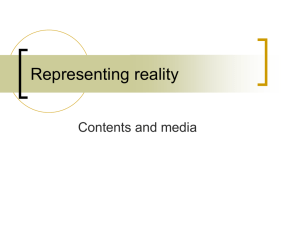
From: FLAIRS-01 Proceedings. Copyright © 2001, AAAI (www.aaai.org). All rights reserved.
Heterogeneous BDI Agents I: Bold Agents
Maria Fasli
University of Essex
Department of ComputerScience
WivenhoePark, Colchester, CO43SQ, UK
mfasli @essex.ac.uk
Abstract
Oneof the mostinterestingissues that arises in agentsbased
on the BDI(belief-desire-intention) formalismis capturing
notionsof realism,that is constraintsthat describepossible
interrelationshipsbetween
the three attitudes. Threesuchsets
of constraintshavebeenconsideredin the literature: strong
realism, realismand weakrealism. In this paperwe propose
notions of realism for heterogeneousBDIagents and in particular weexplore whatwe call bold agents. Weinterpret
boldBDIagents as agents that are willing to take risks, and
thus adoptintentions eventhoughthey maynot believein all
respectiveaccessibleworldsthat these are achievable.
Keywords:
Intelligent Agents,BDIModels,AgentTheories
Introduction
Agents are obviously highly complicated systems and formal theories that describe and explain their behaviour are
of interest to the agent community.Weconsider agent theories as specifications, and we are mainly concerned with
building a useful and expressive theory capable of capturing
agents with a sufficient degree of rationality. In particular
we opt for developing formalismsthat capture relationships
betweenthe various elements of an agent’s cognitive state.
The classical BDI paradigm of Rao and Georgeff (Rao
and Georgeff 1991), (Rao and Georgeff 1998) describes
agents as having three propositional attitudes: beliefs, desires and intentions. Oneof the mostinteresting issues that
arises is defining notions of realism, that is constraints that
describe possible interrelations betweenbeliefs, desires and
intentions. Onewayto describe these constraints is in terms
of relations between the sets of accessible worlds. Three
such sets of constraints knownas strong realism, realism
and weak realism, Figure 1, have been explored. Weregard these three notions as the first step towardsconceptualising heterogeneousagents, that is agents that mayhave a
different cognitive modelwhich mayrender them more suitable for someapplications than others. This paper touches
uponsomeof the issues on the relationships betweenthe intentional notions. In particular, motivated by the work of
Raoand Georgeff and by their remark that other useful BDI
systems can be constructed, we propose notions of realism
Copyrightt~) 2001, American
Associationfor Artificial Intelligence(www.aaai.org).
All rights reserved.
for capturing bold agents in the BDI framework. The paper is organised as follows. In the next section we present
the classical BDIparadigm. Next we discuss our motivation
and basic ideas behind heterogeneousagents and the concept
of a bold agent. The four subsequent sections discuss four
notions of realism formalising bold agents along with their
properties. Due to space limitations lemmasand theorems
are stated without proof. A summaryand a brief discussion
of our findings is then provided and the paper ends with the
conclusions and a pointer to future work.
The BDI Framework
Motivatedby the need to express an agent’s cognitive state
in terms of both information attitudes and pro-attitudes
and influenced by Bratman’s philosophical work on intentions (Bratman1987), Rao and Georgeff developed the BDI
framework (Rao and Georgeff 1991), (Rao and Georgeff
1998). The BDI frameworkis a theoretical formalism in
whichan agent’s information state is described in terms of
beliefs, its motivationalstate in terms of desires (or goals),
and its deliberation state in terms of intentions.
The logical languageis a first order languagewhichapart
from the usual connectives, and quantifiers also includes
three modal operators Beli, Desk, Intend/for expressing
beliefs, desires and intentions respectively. Thus, the formula Beli(¢) meansthat agent i believes proposition ¢. In
addition the frameworkuses a branching temporal component based on CTLlogic (Computational Tree Logic),
whichthe belief-, intention-, and desire-accessible worlds
are themselves branching time structures. Due to lack of
space we will not present the temporal part of the BDI
frameworkbut its details can be found in (Rao and Georgeff
1991) and (Rao and Georgeff 1998).
The semantics of the BDIframeworkis based on the notion of possible worlds. The basic concept behind possible
worldsis that besidesthe true state of affairs, the real world,
there are other possible states of affairs or worlds relative
to an agent. Thus there is a set Wof accessible worlds
whichare connected with accessibility or possibility relations. Anaccessibility relation indicates the possible worlds
relevant to an agent’s perspective. Thus, B~is the accessibility relation for belief for agent i, and similarly for ID/and
2"/. Aninterpretation for the logical language/~is a tuple
M=< W, Lt, Tr,13,79,2- > where Wis a set of possible
INTELLIGENT
AGEliTS 195
worlds, H is the universe of discourse, and 7r determinesthe
truth values of the atomic formulas of the language. B, ~D,
and 2-, mapthe agents’ current situation to their belief-,
desire- and intention-accessible situations respectively. The
semanticsfor the intentional notions is therefore as follows:
M, w ~ Beli(¢) iffV w’ such that Bi(w, w’), M, w’ ~
M, w ~ Desi(q~) iffV w’ such that :Di(w, w’), M, w’ ~
M, w ~ Intendi(¢) iffVw’ such that2-i(w, w’), M, w’ ~
The first clause states that a formula ¢ is believed in a
worldw if and only if it is true in all its belief-accessible
(Bi) worlds. By imposing restrictions on the accessibility
relations we can capture certain axioms.Thus, Bi is taken to
be serial, transitive and symmetric,and Di and 7.i are serial.
The basic BDIaxiomatisation is as follows:
Belief
Beli(¢) A Beli(¢ ¢)~ Bel i(¢) (Distribution Axi om)
Beli((b) ~ -~Beli(~¢) (D axiom, seriality)
Beli( ¢) ~ Beli( Beli( q~) ($4 axiom, tr ansitivity)
-~Beli(¢) ~ Beli(-~Beli(¢) ($5 axiom, symmetry)
if ~- ¢ then I- Bell(C) (Necessitation Rule)
Desires
Desi(¢) A Desi(¢ =~ ~b) =~ Desi(~b)
Des(¢)
ifl- ¢ then I- Desi(¢)
Intentions
Intendi(¢) A Intendi(¢ ¢)=:>Inte ndi(¢)
Intendi( ¢ ) ~ -~Intendi(-~¢
if I- ¢ then ~- Intendi(¢)
The Distribution axiomand the Necessitation rule are inherent of the possible worlds approachand they hold regardless of any restrictions that we mayimpose on the accessibility relations. Thusthe agents are logically omniscient
(Faginet al. 1995)regardingtheir beliefs, desires and intentions. Before proceeding a note needs to be made. Since
the temporal component has not been presented some of
the schemasthat will be introduced such as Intend(C)
Bel(¢) mayappear unintuitive. This schemashould be read
as: if an agent intends ¢ then it believes it to be possible or
achievable sometime in the future.
Notions of Realism
It is reasonableto assumethat an agent’s beliefs affect its desires and intentions as well as the courseof actions that it is
going to take in order to achieve them. Onewayof defining
relations betweenthe three attitudes is by imposingconditions on the set relations of the belief, desire, and intentionaccessible worlds. These constraints are called notions of
realism and the interesting and meaningfulones can be characterised semantically and captured axiomatically. Raoand
Georgeff have considered three such notions which suggest
waysin whichthe propositional attitudes could be related to
each other yielding different types of agents.
In the first notion of realism called strong realism the
set of belief accessible worlds is a subset of the desireaccessible worlds, and the set of desire accessible worlds is
a subset of the intention accessible worlds, as is illustrated
in Figure l(i). Set containmentcorrespondsto logical implication and thus the relationships betweensets of accessible
196
FLAIRS-2001
B
i)
ii~
iiO
Figure 1: i) Strong Realism, ii) Realismiii) WeakRealism
worlds entail the following axioms:
Intendi(¢) ~ Desi(¢)
Desi(¢) ~ Beli(¢)
l.emma I The connection axioms for strong realism are
soundin all modelsthat satisfy the semanticconditions:
(0 WoVw’
79~(w, w’) ~ Z~(w,
(ii) VwVw’Bi(w, w’) ~ Z)i(w,
Thus, S-BDI(S-: Strong realism) comprises of the BDI
logic and the axiomsfor strong realism. Accordingto strong
realism the agent is very cautious, and only intends and desires propositionsthat believes to be achievable,Figure1 (i).
In realism the set of intention accessible worlds is a subset of the desire-accessible worlds, and the set of desireaccessible worldsis a subset of the belief-accessible worlds.
Theserelations are depicted in Figure l(ii). Therealism axiomsthat ensuefrom the set relations are the following:
Beli(¢) ~ Desi(¢)
Zmendd¢)
[,emma2 The connection axioms for realism are sound in
all modelsthat satisfy the semanticconditions:
(0 VwVw’
w’) t i(
(ii) wvw’
zdw,o’) =. 79,(w,w’)
The R-BDIlogic (R-:Realism) consists of the basic BDI
axiomatisation and the realism axioms. An agent based on
the realism constraints is an enthusiastic agent and believes
that it can achieve its desires and intentions, Figure l(ii).
Realism was employed by Cohen and Levesque (Cohen and
l_evesque1990)in their theory of intentions.
Finally, in weak realism, the intersection of intentionand desire-, intention- and belief-, and belief- and desireaccessible worlds is not the emptyset as is shownin Figure
l(iii). The axiomschemasfor weakrealism are as follows:
Intendi( ¢) ~ -~Desi(-~¢)
Intendi ( ¢ ) ~ -,Beli (-,¢
Desi(¢) ~ -~Beli(-~¢)
Lemma3 The connection axioms for weak realism are
soundin all modelsthat satisfy the semantic conditions.
(i) Vw3w’such that 2-i(w, w’) A Z)i(w,
t such that Zi(w, w’) A Bi(w,
(ii) Vwqw
(iii) Vwqw’such that 7)i(w, w’) A 13i(w, t)
A1
A2
A3
A4
AS
A6
A7
A8
A9
I-B Inconsistency
I-B Incompleteness
I-D Incompleteness
I-D Inconsistency
B-D Incompleteness
B-I Incompleteness
D-BInconsistency
D-I Incompleteness
D-B Incompleteness
t- Intendi(¢) ~ ~Beli(-~¢)
[/Intendi (¢/::¢" Bell (¢)
~/
Des~(¢)
~- Intend~(¢)
Intendi(¢) =~
~ -~Desi(-~¢)
~/ Beli(¢) =~ Desi(¢)
V Beli(¢) =¢, Intendi(¢)
t- Desi(¢) ~ -~Belit ~¢)
Desi (¢) =¢, Intencli (¢)
~/ Des~(¢) =~ Beli(¢)
Table 1: AsymmetryThesis Principles.
S.
R~
W.
A1 A2
F
T
T
T
T
T
A3
F
T
T
A4
T
T
T
A5
T
F
T
A6
T
F
T
A7
T
T
T
A8
T
F
T
A9
F
T
T
Table 2: Asymmetry
Thesis in classical BDISystems.
As in the previous two notions of realism, the enhanced
systems will be distinguished by the letter W-in front of
their name. The agent described by the weak realism constraints is a morebalanced agent than the other two types.
Asymmetry thesis and Consequential Closure
Bratman (Bratman 1987) and Rao and Georgeff (Rao
Georgeff1998), discussed several conditions that should be
taken into account in a logical formalism if we are to say
that an agent is acting rationally. Theseconditions are also
knownas the asymmetrythesis or the incompleteness and
the inconsistency principles, and they hold pairwise between
desires, beliefs, and intentions. Theyare listed in Table
1. Accordingto Rao and Georgeff, the three inconsistency
principles (A1,A4,A7)are expressed as axioms, the rest
the principles are expressed as formulas that should not be
valid. Wewill explain the first two and similar comments
can be madefor the rest of them. In Intention-Belief Inconsistency if an agent intends to do somethingit should not believe it to be impossible. In Intention-Belief Incompleteness
an agent can havethe intention to do an act but not necessarily believethat it will doit. In Table2 the fulfillmentof these
properties in the classical BDIlogics underthe constraints of
strong realism, realism and weak realism are repeated from
(Rao and Georgeff 1998).
Apart from the asymmetrythesis, the principles of consequential closure (CC)state additional properties that should
be satisfied by an agent’s beliefs, desires and intentions. For
instance, it is required that an agent that intends ¢1 and believes that (¢1 ::~ ¢2) need not intend ¢2. Thus, an agent
that intendsto go to the dentist and believesthat a visit to the
dentist implies pain, it does not necessarily intend to suffer
pain. Similarly, if an agent intends ¢1 and desires ¢1 ~ ¢2,
it neednot intend ¢2 and finally, if an agent desires ¢1 and
believes ¢1 =~ ¢2, it maynot necessarily desire ¢2. These
intuitions are captured by the following formulas:
CC1. Intendi(¢l) A Beli(¢l ¢2)A -~Intendi(¢2)
CC2. Inte’ndi(¢l) A Des~(¢1 =~ ¢2) A -~Intendi(¢2)
CC3. Desi(¢l) A Bell(el ==~¢2) A -~Desi(¢2)
The satisfiability of these formulas dependsuponthe additional realism constraints, thus:
Proposition 4 (Rao and Georgeff 1998, pp 332):
a) The CCprinciples are satisfiable in S-BDI.
b) The CCprinciples are not satisfiable in R-BDL
c) The CCprinciples are satisfiable in W-BDI.
Motivation
It is reasonableto suggest that different domainsof applications for agents have different requirements, whichneed to
be reflected in the conceptualisation, design, and implementation of the agents. For instance, an agent that has to deal in
the stock exchangemarket should have a different reasoning
modelfroman agent that acts as an air-traffic controller. The
stock exchangeagent needs to be able to engagein transactions that involvesomerisk, whereasan air-traffic controller
agent needs to be strictly a cautious agent and avoid decisions that involve uncertainty and risk. Thus, the need for
heterogeneousagents stems from the fact that the cognitive
modelof the agent mayhave to vary depending on the requirementsof a particular application. In the level of agent
theories and in particular in the BDIparadigmthis need is
addressed by adopting different realism constraints. Three
such constraints have been considered: strong realism, realism and weakrealism. In this paper we are interested in
finding suitable constraints for characterising agents that are
willing to take risks, such as the stock exchangeagent in
the exampleabove. Wewill refer to such agents as "bold"
agents. Weinterpret bold agents in the BDIframeworkas
agents that mayintend a proposition if they do not at least
believe it to be unachievable. Therefore, a bold agent may
adoptan intention evenif it doesnot believein all its beliefaccessible worldsthat it is achievable.
The notion of realism adopted by Raoand Georgeff characterises an enthusiastic agent. It is therefore plausible for
the agent to adopt an intention even though it maynot believe in all belief-accessible worldsthat it is achievable.
However,according to the realism constraints wheneverthe
agent believes somethingin all worlds, then it will intend it
as well (CC1). Thus, although agents are enthusiastic, they
are not bold in our sense. In realism none of the consequential closure principles is satisfied. Hence,if the agent
believes that by bombinga weaponsfactory it will kill the
children in the nearby school, and intends to bombthe factory, it will intend to kill the children as well. Weakrealism
captures bold agents and overcomesthe problems of realism. Our aim has been to thoroughlyinvestigate the space of
possibilities betweenrealism and weak realism constraints
in order to capture bold agents.
On the opposite end of bold agents stand circumspect
agents. Circumspectagents are not willing to take any risks
and they will only adopt intentions if they believe in all accessible worlds that they are achievable. However,we will
not be concernedwith circumspect agents here; future work
will address such issues. In the subsequentsections we will
present four notions of realism for capturing bold agents that
seemto have interesting properties.
INTELLIGENT
AGENTS 197
l
et
i)
I
ii}
ii)
Figure 2: Set Relationships: i) RI-BDI,ii) R2-BDI
Figure 3: Set Relationships: i) R3-BDI,ii) R4-BDI
R1-BDIRealism
2(ii), the set of desire-accessible worldsis a subset of the
belief-accessible worlds, and the intersection of desire- and
intention-accessible worlds is not the emptyset. Theseset
restrictions yield the followingaxioms:
Desi(¢) ~ -~Intendi(~¢)
Beli(¢) ~ Desi(¢)
Lemma
7. The axioms for R2-BDIrealism are sound in
all modelsthat satisfy the followingsemanticconditions:
Webegin our investigation into possible notions of realism
for conceptualising bold agents by considering a set of constraints based on the traditional notion of realism with a
modification. In RI-BDIrealism the agent intends its desires and can adopt intentions eventhoughit maynot believe
that they are achievable in all possible worlds. Hence, in
terms of set relations, the set of intention-accessible worlds
is a subset of the desire-accessible worlds and the intersection of belief- and intention-accessible worldsis not the
emptyset, as depictedin Figure2 (i).
Theseset relationships yield the following axioms:
Desi(¢) =~ Intendi(¢)
Zntendi(¢) ~ ~Beli(-~¢)
/.,emma 5. The axioms for R1-BDIrealism are sound in
all modelsthat satisfy the following semanticconditions:
(i) VwVw’Z~(w, w’) =~7~,(w,
(ii) Vw3w’Bi(w, w’) A Z~(w,
The respective system called RI-BDIcomprises of the basic BDIaxiomatisation and the axioms for RI-BDIrealism.
The following are derivable:
Zntendi(¢) ~ Desi(¢)
Des~( ¢) =~-~Bel,(-~¢)
Furthermore, we can imposethe following axioms providing
further relationships betweenbeliefs, desires and intentions:
BL Intendi(¢) ~ Beli(Intendi(¢))
BD. Des,(¢) ~ Be4(Des,(¢))
Lemma
6. The above axioms are sound in all models that
satisfy the following semanticconditions respectively:
BLWo,
~o’,w"t~(w,w’)AZ~(w’,~o"):. Z~(w,
BD.Vw,w’, w" Bi(w, w’) A l)~(w’, w") =~ Vi(w,
Adopting the BDsemantic condition in R1-BDIsystems
yields the following formula being a theorem:
Desi(¢) =~ Beli(Intendi(¢))
The satisfaction of the AsymmetryThesis and the Consequential Closure principles for R1-BDIas well as the remainingnotions of realism is given in Tables 3 and 4.
R2-BDIRealism
In R2-BDIrealism if the agent believes a proposition it
will have a desire towards that proposition, but its desires
and beliefs are loosely coupled with its intentions. Thus
the agent can adopt intentions, even though it maynot believe them in all possible worlds to be achievable and it
can also adopt an intention even though it maynot desire
that proposition in all possible worlds. As shownin Figure
198
D
FLAIRS-2001
wo3w’
V~(w,
~o’)AZ~(~o,
WVw’
V,(~o,~.’)
~ ~(~o,w’)
The respective system is called R2-BDIsystem. The followingare theorems in this system:
Intendi ( ¢ ) =~-~Beli(-~¢
Desi( ¢ ) =~-~Beli(-~¢
Wecan also add the axiomsIB and DBto capture further
interrelationships betweenthe three notions (Lemma6).
R3-BDIRealism
The R3-BDInotion of realism is based on the same intuitions as R2-BDIrealism, namelythat the agent can form an
intention even though it maynot have complete information
that it is achievable in all possible worlds. The difference
is located in the wayintentions are related to desires. Thus,
the set of desire-accessible worldsis a subset of the beliefaccessible worlds, the set of desire accessible worlds is a
subset of the intention-accessible worldsas well, and the intersection of the belief- and intention-accessible worlds is
not the emptyset as is depicted in Figure 3(i). Theseintuitions are captured by the following axioms:
Intendi(¢) :=~ Oesi(¢)
Beli(¢) Des~(¢)
Lemma8. The axioms for R3-BDIrealism are sound in
all modelsthat satisfy the followingsemanticconditions:
VwVw’
79i(w,w’) ~ ~(w, w’)
ww’z~(w, w’) mB~(w,
The respective R3-BDIsystem comprises of the basic
BDIaxiomatisation and the axioms for R3-BDIrealism. The
following are theorems:
Intendi( ¢) =~-~Bel~(-~¢
De~(¢)~ -~Bel,(-~¢)
Desi ( ¢ ) =~-~Intendi(-~¢
As in the previous two notions of realism for bold agents we
imposeadditional semantic constraints (Lemma6) in order
to capture the followingprinciples:
Intendi(¢) :=~ Beli (Intendi (¢))
Desi(¢) =:~ Beli(Desi(¢)
Furthermore adopting the semantic condition BI yields
the following being a theorem in R3-BDIsystem:
Intendi(¢) =~ Beli(Des,(¢))
R4-BDI Realism
In R4-BDIrealism the set of intention-accessible worlds of
an agent is a subset of the desire-accessible worlds, and the
intersection of desire- and belief-accessible worldsis not the
emptyset, Figure 3(ii). Theaxiomscapturing these relations
of R4-BDIrealism are as follows:
Beli(¢)
~ -~Desi(-~¢)
Inten&(¢) ~ mesi(¢)
Lemma
9. The axioms for R4-BDIrealism are sound in
all modelsthat satisfy the followingsemantic conditions:
R1
R2
R3
R4
A1
T
T
T
T
A2
T
T
T
T
A3
T
T
F
F
A4
T
T
T
T
A5
T
F
F
T
A6
T
T
T
T
A7
T
T
T
T
A8
F
T
T
T
A9
T
T
T
T
Table 3: AsymmetryThesis in Systems for Bold Agents
R1
R2
R3
R4
C1
T
T
T
T
C2
F
T
T
T
C3
T
F
F
T
Table 4: Consequential Closure in Systems for Bold Agents
wowo’
79 ( o, z (w, w’)
Anagent based on R4-BDIrealism is characterised as being bold, and if it intends a proposition it will havea desire
towardsthat proposition, but it will not necessarily desire all
its beliefs. The respective derived systemis called R4-BDI.
The following are theoremsin this system:
Intendi(¢) ~-~Bel~(-~¢)
Des(¢)
Des(¢)
Axiomsproviding further relationships betweenthe three
notions can be included in R4-BDIby imposing additional
semantic conditions (Lemma
2). In particular adopting BI as
an axiomin R4-BDIsystem entails the following theorem:
Intendi(¢) ~ Beli(Desi(¢))
All ConsequentialClosureprinciples are satisfiable in R4BDIrealism (Table 4). The satisfaction of the Asymmetry
Thesis is providedin Table3.
Comparison
and Conclusions
The research presented in this paper has been driven by
the need to formalise heterogeneousagents and in particular bold agents in the classical BDIparadigm. Bold agents
are interpreted in the BDIframeworkas agents that are willing to adopt intentions even though they maynot believe
in all their belief-accessible worldsthat their intentions are
achievable. The paper in particular discussed four different types of realism constraints for bold agents. The properties of agents based upon these notions of realism were
presented. In the scope of this research and in the effort to
investigate all the available options betweenthe notions of
realism and weak realism 8 additional possible notions of
realism were uncovered. Due to lack of space we only described those available options that seemto yield the most
reasonableproperties for agents.
Oneway of evaluating these different notions of realism
and the respective systems, is by checking the asymmetry
thesis and the consequentialclosure principles. Tables 3 and
4 summarise the asymmetrythesis and consequential closure properties for this category of agents. Checkingthese
two tables and comparing them with Table 2 and Proposition 4 we see that all four systems proposedfor bold agents
yield nicer features than realism. In RI-, R2- and R3-BDI
realism only one of the consequential closure principles is
not satisfied, whereasin R4-BDIrealism all of themare satisfied. Furthermore,although in the notion of realism three
of the asymmetrythesis principles are not fulfilled, in R3BDI two of them are not, whereas in RI-,R2- and R4-BDI
only one is not fulfilled. So our specifications for BDIbold
agents comecloser to the desiderata laid downby Bratman,
and Rao and Georgeff. Of course this is with the exception of weakrealism where the asymmetrythesis and all the
consequential closure principles are satisfied. To sumup,
the alternative notions for bold agents seemto satisfy some
of our intuitions about the relations betweenthe intentional
notions and offer nice features and properties that seem to
comecloser to the desiderata for rational reasoning agents
than the classical notion of realism.
The notions of realism presented here have only been examinedwith respect to the relationships betweenthe three
sets of accessible words. Spacedid not allow us to present
the temporal componentof BDIlogics as well as present the
properties of these notions of realism for bold agents with
respect to the structure of possible worlds. Furthermore,
extensions of the work presented here involve research under wayinvestigating possible frameworksfor capturing circumspect(cautious) agents. An extendedversion of this paper will cover all the aforementionedissues.
References
Bratman M.E. 1987. Intentions, Plans and Practical Reason. Cambridge,Mass.:HarvardUniversity Press
CohenP.R. and Levesque H.J. 1990. Intention is Choice
with Commitment.
Artificial Intelligence, 42:213-261
Fagin et.al. 1995. Reasoning about Knowledge. Cambridge
Mass.: The MITPress
Rao A. and Georgeff M. 1991. Modeling Rational Agents
within a BDI-Architecture. Proceedings of the 2nd bit.
Conf. on Principles of KnowledgeRepresentation and Reasoning, San Mateo, Calif.: MorganKaufmannPublishers
Rao A. and Georgeff M. 1998. Decision Procedures for BDI
Logics. Journal of Logic and Computation,8(3):293-343
INTELLIGENT
AGENTS 199




